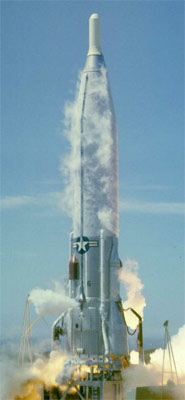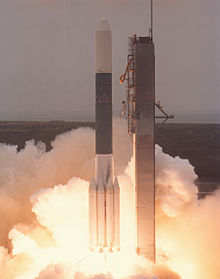
The Space Shuttle is a retired, partially reusable low Earth orbital spacecraft system operated from 1981 to 2011 by the U.S. National Aeronautics and Space Administration (NASA) as part of the Space Shuttle program. Its official program name was Space Transportation System (STS), taken from a 1969 plan for a system of reusable spacecraft where it was the only item funded for development.

Delta II was an expendable launch system, originally designed and built by McDonnell Douglas, and sometimes known as the Thorad Delta 1. Delta II was part of the Delta rocket family and entered service in 1989. Delta II vehicles included the Delta 6000, and the two later Delta 7000 variants. The rocket flew its final mission ICESat-2 on 15 September 2018, earning the launch vehicle a streak of 100 successful missions in a row, with the last failure being GPS IIR-1 in 1997.

The Delta rocket family is a versatile range of American rocket-powered expendable launch systems that has provided space launch capability in the United States since 1960. Japan also launched license-built derivatives from 1975 to 1992. More than 300 Delta rockets have been launched with a 95% success rate. The series has been phased-out in favor of the Vulcan Centaur, with only the Delta IV Heavy rocket remaining in use as of June 2023.

The Space Shuttle Solid Rocket Booster (SRB) was the first solid-propellant rocket to be used for primary propulsion on a vehicle used for human spaceflight. A pair of these provided 85% of the Space Shuttle's thrust at liftoff and for the first two minutes of ascent. After burnout, they were jettisoned and parachuted into the Atlantic Ocean where they were recovered, examined, refurbished, and reused.

A solid rocket booster (SRB) is a large solid propellant motor used to provide thrust in spacecraft launches from initial launch through the first ascent. Many launch vehicles, including the Atlas V, SLS and Space Shuttle, have used SRBs to give launch vehicles much of the thrust required to place the vehicle into orbit. The Space Shuttle used two Space Shuttle SRBs, which were the largest solid propellant motors ever built and the first designed for recovery and reuse. The propellant for each solid rocket motor on the Space Shuttle weighed approximately 500,000 kilograms.

Titan IV was a family of heavy-lift space launch vehicles developed by Martin Marietta and operated by the United States Air Force from 1989 to 2005. Launches were conducted from Cape Canaveral Air Force Station, Florida and Vandenberg Air Force Base, California.

The Titan IIIC was an expendable launch system used by the United States Air Force from 1965 until 1982. It was the first Titan booster to feature large solid rocket motors and was planned to be used as a launcher for the Dyna-Soar, though the spaceplane was cancelled before it could fly. The majority of the launcher's payloads were DoD satellites, for military communications and early warning, though one flight (ATS-6) was performed by NASA. The Titan IIIC was launched exclusively from Cape Canaveral while its sibling, the Titan IIID, was launched only from Vandenberg AFB.

Atlas II was a member of the Atlas family of launch vehicles, which evolved from the successful Atlas missile program of the 1950s. The Atlas II was a direct evolution of the Atlas I, featuring longer first stage tanks, higher-performing engines, and the option for strap-on solid rocket boosters. It was designed to launch payloads into low Earth orbit, geosynchronous transfer orbit or geosynchronous orbit. Sixty-three launches of the Atlas II, IIA and IIAS models were carried out between 1991 and 2004; all sixty-three launches were successes, making the Atlas II a highly reliable space launch system. The Atlas line was continued by the Atlas III, used between 2000 and 2005, and the Atlas V which is still in use.

Geosynchronous Satellite Launch Vehicle (GSLV) is a class of expendable launch systems operated by the Indian Space Research Organisation (ISRO). GSLV has been used in fifteen launches since 2001.

The Thor-Able was an American expendable launch system and sounding rocket used for a series of re-entry vehicle tests and satellite launches between 1958 and 1960.

The Atlas-Centaur was a United States expendable launch vehicle derived from the SM-65 Atlas D missile. The vehicle featured a Centaur upper stage, the first such stage to use high-performance liquid hydrogen as fuel. Launches were conducted from Launch Complex 36 at the Cape Canaveral Air Force Station (CCAFS) in Florida. After a strenuous flight test program, Atlas-Centaur went on to launch several crucial spaceflight missions for the United States, including Surveyor 1, Mariner 4, and Pioneer 10/11. The vehicle would be continuously developed and improved into the 1990s, with the last direct descendant being the highly successful Atlas II.

The Launch Vehicle Mark-3 or LVM3 is a three-stage medium-lift launch vehicle developed by the Indian Space Research Organisation (ISRO). Primarily designed to launch communication satellites into geostationary orbit, it is also due to launch crewed missions under the Indian Human Spaceflight Programme. LVM3 has a higher payload capacity than its predecessor, GSLV.
Thor was a US space launch vehicle derived from the PGM-17 Thor intermediate-range ballistic missile. The Thor rocket was the first member of the Delta rocket family of space launch vehicles. The last launch of a direct derivative of the Thor missile occurred in 2018 as the first stage of the final Delta II.

The Titan 34D was a United States expendable launch vehicle used to launch a number of satellites for military applications.

The SM-65D Atlas, or Atlas D, was the first operational version of the U.S. Atlas missile. Atlas D was first used as an intercontinental ballistic missile (ICBM) to deliver a nuclear weapon payload on a suborbital trajectory. It was later developed as a launch vehicle to carry a payload to low Earth orbit on its own, and later to geosynchronous orbit, to the Moon, Venus, or Mars with the Agena or Centaur upper stage.

The SM-65E Atlas, or Atlas-E, was an operational variant of the Atlas missile. It first flew on October 11, 1960, and was deployed as an operational ICBM from September 1961 until April 1966. Following retirement as an ICBM, the Atlas-E, along with the Atlas-F, was refurbished for orbital launches as the Atlas E/F. The last Atlas E/F launch was conducted on March 24, 1995, using a rocket which had originally been built as an Atlas E.

The SM-65F Atlas, or Atlas-F, was the final operational variant of the Atlas missile, only differing from the Atlas E in the launch facility and guidance package used. It first flew on 8 August 1961, and was deployed as an operational ICBM between 1961 and 1966. Following retirement as an ICBM, the Atlas-F, along with the Atlas-E, was refurbished for orbital launches as the Atlas E/F.

The Titan IIIE or Titan 3E, also known as the Titan III-Centaur, was an American expendable launch system. Launched seven times between 1974 and 1977, it enabled several high-profile NASA missions, including the Voyager and Viking planetary probes and the joint West Germany-U.S. Helios spacecraft. All seven launches were conducted from Cape Canaveral Air Force Station Launch Complex 41 in Cape Canaveral, Florida.

GPS IIR-1 or GPS SVN-42 was the first Block IIR GPS satellite to be launched. It was to have been operated as part of the United States Air Force Global Positioning System. It was launched on 17 January 1997, and was destroyed 13 seconds into its flight due to a malfunction of the Delta II launch vehicle that was carrying it. It was estimated to have cost US$40 million, with its launch vehicle costing US$55 million. The satellite that was used for the GPS IIR-1 mission was the second production IIR satellite, SVN-42.



















